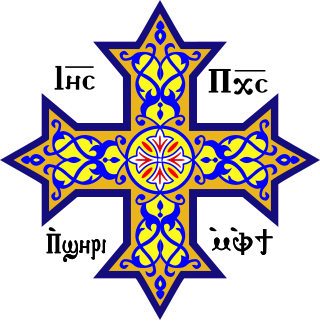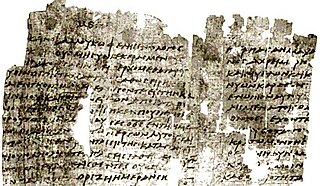
Papyrus 46, designated by siglum 𝔓46, is an early Greek New Testament manuscript written on papyrus, and is one of the manuscripts comprising the Chester Beatty Papyri. Manuscripts among the Chester Beatty Papyri have had several provenances associated with them, the most likely being the Faiyum. It has been paleographically dated between 175 and 225, or early 3rd century CE. It contains verses from the Pauline Epistles of Romans, 1 Corinthians, 2 Corinthians, Galatians, Ephesians, Colossians, Philippians, 1 Thessalonians, and Hebrews. Some leaves are part of the Chester Beatty Biblical Papyri, and others are in the University of Michigan Papyrus Collection.

The Bodmer Papyri are a group of twenty-two papyri discovered in Egypt in 1952. They are named after Martin Bodmer, who purchased them. The papyri contain segments from the Old and New Testaments, early Christian literature, Homer, and Menander. The oldest, P66 dates to c. 200 AD. Most of the papyri are kept at the Bodmer Library, in Cologny, Switzerland outside Geneva.

There have been many Coptic versions of the Bible, including some of the earliest translations into any language. Several different versions were made in the ancient world, with different editions of the Old and New Testament in five of the dialects of Coptic: Bohairic (northern), Fayyumic, Sahidic (southern), Akhmimic and Mesokemic (middle). Biblical books were translated from the Alexandrian Greek version.
A biblical manuscript is any handwritten copy of a portion of the text of the Bible. Biblical manuscripts vary in size from tiny scrolls containing individual verses of the Jewish scriptures to huge polyglot codices containing both the Hebrew Bible (Tanakh) and the New Testament, as well as extracanonical works.

Papyrus 13, designated by siglum 𝔓13 or P13 in the Gregory-Aland numbering, is a fragmentary manuscript of the New Testament in Greek. It was copied on papyrus in the 3rd century at approximately 225-250 CE.

The Chester Beatty Biblical Papyri or simply the Chester Beatty Papyri are a group of early papyrus manuscripts of biblical texts. The manuscripts are in Greek and are of Christian origin. There are eleven manuscripts in the group, seven consisting of portions of Old Testament books, three consisting of portions of the New Testament, and one consisting of portions of the Book of Enoch and an unidentified Christian homily. Most are dated to the 3rd century CE. They are housed in part at the Chester Beatty Library in Dublin, Ireland, and in part at the University of Michigan, among a few other locations.

Papyrus 45, designated by siglum 𝔓45 in the Gregory-Aland numbering of New Testament manuscripts, is an early Greek New Testament manuscript written on papyrus, and is one of the manuscripts comprising the Chester Beatty Papyri, a group of early Christian manuscripts discovered in the 1930s, and purchased by business man and philanthropist, Alfred Chester Beatty. Beatty purchased the manuscript in the 1930s from an Egyptian book dealer, and it was subsequently published in The Chester Beatty Biblical Papyri, Descriptions and Texts of Twelve Manuscripts on Papyrus of the Greek Bible by palaeographer, biblical and classical scholar Frederic G. Kenyon in 1933. Manuscripts among the Chester Beatty Papyri have had several places of discovery associated with them, the most likely being the Faiyum in Egypt. Using the study of comparative writing styles (palaeography), it has been dated to the early 3rd century CE. This therefore makes it the earliest example of not only the four Gospels contained in one volume, but also the Acts of the Apostles. It contains verses in fragmentary form from the texts of Matthew chapters 20–21 and 25–26; Mark chapters 4–9 and 11–12; Luke chapters 6–7 and 9–14; John chapters 4–5 and 10–11; and Acts chapters 4–17.

Papyrus 4 is an early New Testament papyrus of the Gospel of Luke in Greek. Opinions differ as to its age. It has been dated anywhere from the late second century to the fourth century.

Papyrus 5, designated by siglum 𝔓5, is an early copy of the New Testament in Greek. It is a papyrus manuscript of the Gospel of John dating palaeographically to the early 3rd century. The papyrus is housed in the British Library. It has survived in a very fragmentary condition.

Papyrus 6, designated by 𝔓6 or by ε 021, is a fragmentary early copy of the New Testament in Greek and Coptic (Akhmimic). It is a papyrus manuscript of the Gospel of John that has been dated paleographically to the 4th century. The manuscript also contains text of the First Epistle of Clement, which is treated as a canonical book of the New Testament by the Coptic Church. The major part of the codex is lost.
Papyrus 14, α 1036, signed by 𝔓14, is an early copy of the New Testament in Greek. It is a papyrus manuscript written in form of codex. The manuscript palaeographically has been assigned to the 5th century.

Papyrus 23, designated by 𝔓23, is an early copy of the New Testament in Greek. It is a papyrus manuscript of the Epistle of James, it contains only James 1:10-12,15-18. The manuscript paleographically has been assigned to the early 3rd century.

Papyrus 47, designated by siglum 𝔓47, is an early Greek New Testament manuscript written on papyrus, and is one of the manuscripts comprising the Chester Beatty Papyri. Manuscripts among the Chester Beatty Papyri have had several places of discovery associated with them, the most likely being the Faiyum. Using the study of comparative writing styles (palaeography), it has been dated to the early 3rd century CE. The codex contains text from the Book of Revelation chapters 9 through 17. It is currently housed at the Chester Beatty Library in Dublin.
Papyrus 62, signed by 𝔓62, known also as ‘‘Papyrus Osloensis’’, is a copy of the New Testament and Septuagint in Greek-Coptic. It is a papyrus manuscript of the Gospel of Matthew and Book of Daniel. The manuscript palaeographically has been assigned to the 4th century.

Papyrus Rylands 458 is a manuscript of the Pentateuch in the Greek Septuagint version of the Hebrew Bible. It is a roll made from papyrus, which has survived in a very fragmentary condition. It is designated by the number 957 on the list of Septuagint manuscripts according to the numbering system devised by biblical scholar Alfred Rahlfs. Using the study of comparative writing styles (palaeography), the manuscript has been dated to the middle of the 2nd century BCE.

Papyrus 967 is a 3rd-century CE biblical manuscript, discovered in 1931. It is notable for containing fragments of the original Septuagint text of the Book of Daniel, which was completely superseded by a revised text by the end of the 4th century and elsewhere survives only in Syriac translation and in Codex Chisianus 88. The manuscript is also important for early variants, both in the text of the Book of Ezekiel and of the Book of Daniel.

Papyrus Oxyrhynchus 656 – is a Greek fragment of a Septuagint manuscript written on papyrus in codex form. This is a manuscript discovered at Oxyrhynchus, and it has been catalogued with number 656. Palaeographycally it is dated to late second century or early third century.

Jeremiah 4 is the fourth chapter of the Book of Jeremiah in the Hebrew Bible or the Old Testament of the Christian Bible. This book contains prophecies attributed to the prophet Jeremiah, and is one of the Books of the Prophets. Chapters 2 to 6 contain the earliest preaching of Jeremiah on the apostasy of Israel.

Jeremiah 5 is the fifth chapter of the Book of Jeremiah in the Hebrew Bible or the Old Testament of the Christian Bible. This book contains prophecies attributed to the prophet Jeremiah, and is one of the Books of the Prophets. Chapters 2 to 6 contain the earliest preaching of Jeremiah on the apostasy of Israel. This chapter is sub-titled "The Justice of God’s Judgment" in the New King James Version.
The Papyrus Chester Beatty V is a fragment of a Greek Septuagint manuscript written on papyrus. It belongs to the Chester Beatty papyri. Using the study of comparative writing style (palaeography), it has been dated to the late 3rd century CE.















